Using a rifle scope with a Mil-Dot reticle can be a game-changer for shooters who need to make accurate shots at varying distances. The Mil-Dot reticle is a popular type of reticle that allows for range estimation, bullet drop compensation, and windage correction. It consists of a series of evenly spaced dots or hash marks that are spaced one milliradian (mil) apart. One milli radian equals one-thousandth of a radian and is approximately 3.6 inches at 100 yards. The dots are usually located on the crosshairs of the reticle, giving the shooter enough points to use for range estimation and bullet drop compensation.
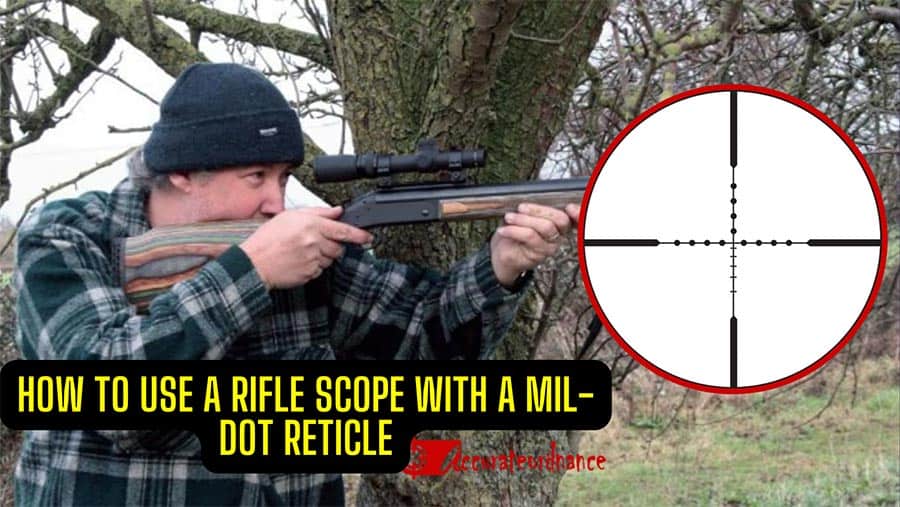
The Mil-Dot reticle is versatile and can be used for various shooting applications, including hunting, target shooting, and tactical operations. Its advantages over other reticles include its ability to estimate range, compensate for bullet drop, and make windage corrections. However, it also has some disadvantages, including a learning curve, potential distraction, and complexity.
To use a Mil-Dot reticle effectively, shooters must learn to estimate range, compensate for bullet drop, and make windage corrections using the dots on the reticle. It takes time and practice to master, but the benefits of using a Mil-Dot reticle can be well worth the effort. Whether you’re a hunter, competitive shooter, or tactical operator, a Mil-Dot reticle can help you make accurate shots at varying distances, giving you a significant advantage in the field.
- Feature On A Mil-dot Reticle
- Advantages of a Mil Dot Reticle
- Disadvantages of a Mil Dot Reticle
- Practical Steps for Using a Mil-Dot Reticle
- FAQs
- What is the functioning principle of a Mil-Dot Reticle?
- Can I use a Mil-Dot Reticle Scope for long-range shooting?
- How do I zero-in a rifle scope with a Mil-Dot Reticle?
- Are Mil-Dot Reticle scopes suitable for hunting?
- How do I estimate range using Mil-Dots?
- What is the significance of bullet drop compensation with a Mil-Dot Reticle?
- How can I compensate for windage using a Mil-Dot Reticle?
- Can I use a Mil-Dot Reticle for shooting moving targets?
Feature On A Mil-dot Reticle
Dots
The dots on a Mil-Dot Reticle are one of its most distinctive features. These dots are usually small circles placed at regular intervals along the crosshairs. The distance between the center of two nearby dots is known as the “mil spacing,” and it is typically one mil (or one milliradian) in size. Mil spacing is a unit of angular measurement that is often used by long-range shooters to estimate the target distance.
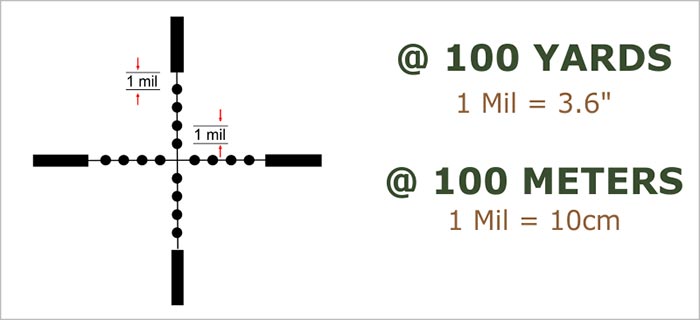
The dots on a Mil-Dot Reticle can be used to measure the size of a target, calculate the range of a target, or compensate for bullet drop. To use the dots for range estimation, the shooter first needs to know the size of the target (in either inches or centimeters). By comparing the size of the target to the number of mils it covers on the reticle, the shooter can estimate the target distance. For example, if a target measures 18 inches and covers 4 mils on the reticle, the range to the target can be estimated at 450 yards (assuming the shooter is using a scope with a 1-mil spacing).
Crosshairs
The crosshairs on a Mil Reticle are the vertical and horizontal lines that intersect at the center of the reticle. The crosshairs are used to aim at the target and provide a reference point for distance measurement using the dots. In a Mil-Dot Reticle, the crosshairs are typically thin and unobtrusive so as not to obscure the target.
When aiming with a mil reticle, the shooter should place the center of the crosshairs on the target and then use the dots to make range estimates or compensate for bullet drop. Depending on the specific reticle design, there may be additional markings or lines on the crosshairs that can be used for windage or elevation adjustments.
Lines
Some Mil-Dot Reticles feature additional lines or markings that can be used for holdovers, windage adjustments, or other factors that can affect bullet trajectory. These lines may be placed along the crosshairs or on the outside of the reticle. For example, some Mil-Dot Reticles have a series of horizontal lines beneath the center crosshair that can be used for holdovers at different ranges.

Illuminated Reticle
Some Mil-Dot Reticles feature illuminated reticle, which can be helpful in low-light conditions. Illumination can also make it easier to see the reticle against dark backgrounds or in shadowed areas. Reticle illumination is typically achieved using LED or fiber-optic technology, and the brightness level can usually be adjusted to suit the shooter’s preferences. When using reticle illumination, it’s important to be aware of battery life and to carry spare batteries in case of a power outage.
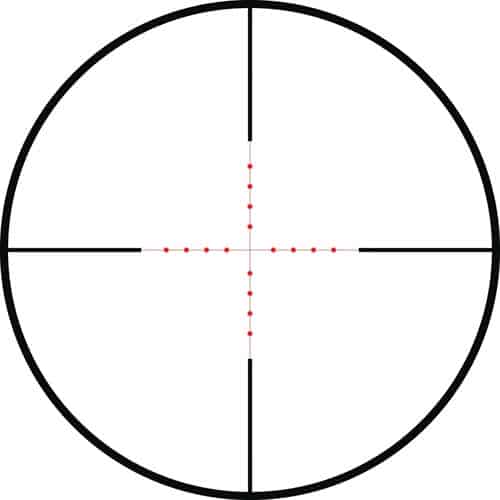
Turrets
The turrets on a mildot reticle are used to adjust the scope’s elevation and windage settings. These adjustments are necessary for compensating for factors such as bullet drop and wind drift. The turrets are usually located on the top and sides of the scope and can be adjusted using either finger or coin slots. The turrets are typically labeled with arrows indicating the direction of adjustment, as well as numbers or markings indicating the amount of adjustment (in mils).
To use the turrets, the shooter must first zero their rifle at a known distance. They can then adjust the turrets to compensate for bullet drop or wind drift at different ranges. Some mildot reticles have “zero stop” turrets that allow the shooter to quickly return to their zero setting after making adjustments.
Magnification Ring
The magnification ring on a mil dot scope is used to adjust the level of magnification on the scope. Higher magnification can help shooters see targets more clearly, but it can also make it harder to keep the reticle steady. The magnification can be adjusted by turning it clockwise or counterclockwise. The level of magnification on a Mil-Dot Reticle can vary depending on the specific model, but it typically ranges from 4x to 24x. The shooter should choose the appropriate magnification level based on the size of the target and the distance to the target.
First or Second Focal Plane

Mil-Dot Reticles can be designed for use either as an FFP scope or an SFP scope. In a first focal plane reticle, the size of the reticle changes as the magnification is adjusted. This means that the mil spacing remains constant with respect to the image regardless of the magnification level. An FFP scope is useful for range estimation and holdover calculations at any magnification level.
In an SFP scope, the size of the reticle remains constant regardless of the magnification setting. Second focal plane reticles are useful for accurately aiming at a specific magnification level, but they require the shooter to know the specific magnification level in order to make range estimates or holdover calculations.
Calibrated for Specific Rounds
Some Mil-Dot Reticles are calibrated for specific rounds, meaning that the reticle markings are designed to correspond with the trajectory of a particular bullet type and weight. Calibrated reticles are typically used for long range shooting applications and can provide more accurate holdover and range estimation calculations than a standard Mil-Dot Reticle.
To use a calibrated reticle, the shooter must first determine the specific bullet type and weight that the reticle is calibrated for. They can then use the reticle markings to make holdover and range estimation calculations that are specific to that bullet. Calibrated reticles are typically more expensive than standard Mil-Dot Reticles and may not be necessary for all shooting applications.
Advantages of a Mil Dot Reticle
There are several advantages to using a mil dot scope, which is why it has become a popular choice among military personnel and other shooters. Here are some of the advantages of a Mil-Dot Reticle:
Range Estimation
One of the primary advantages of a Mil-Dot Reticle is that it allows for quick and accurate range estimation. By using the dots or hash marks on the reticle to measure the size of a target, a shooter can quickly estimate the distance to the target. This is particularly useful in situations where the shooter does not have access to a rangefinder.
Holdover and Windage
Mil-Dot Reticles can also be used to make accurate holdover and windage adjustments. By using the dots or hash marks on the reticle, a shooter can estimate the amount of holdover or windage required for a shot at a specific range. This is useful for compensating for factors such as bullet drop and wind drift.
Versatility
Mil-Dot Reticles are versatile and can be used for a variety of shooting applications, including hunting, tactical shooting, and long range shooting. This is because the reticle can be calibrated for specific rounds and magnification levels, allowing for greater accuracy at different ranges.
Speed
Mil-Dot Reticles allow for quick and efficient target acquisition. By using the dots or hash marks on the reticle to estimate range and make holdover adjustments, a shooter can quickly aim and take their shot if they already know the dot that is accurate for different distances. This is particularly useful in dynamic shooting situations where speed and accuracy are essential.
Illumination
Many Mil-Dot Reticles come with reticle illumination, which can be helpful in low-light shooting conditions. The illumination allows the shooter to see the reticle more clearly and make accurate aim points.
No Need for External Equipment
Unlike rangefinders and other external equipment used for range estimation, holdover, and windage adjustments, a Mil-Dot Reticle is built into the scope itself. This eliminates the need for additional equipment, which can be bulky and time-consuming to use in the field.
Cost-effective
Mil-Dot Reticles are generally less expensive than other types of reticles. This makes them a cost-effective choice for shooters who want to improve their accuracy without breaking the bank.
Consistency
Mil-Dot Reticles are consistent across different scopes and manufacturers. This means that once a shooter learns how to use a Mil-Dot Reticle, they can apply that knowledge to any scope with a Mil-Dot Reticle. This consistency makes it easier for shooters to switch between scopes or upgrade their equipment without having to re-learn a new reticle.
Accurate Shots at Various Ranges
With a Mil-Dot Reticle, a shooter can accurately take shots at various ranges without needing to adjust the scope or dial in the turrets. By using the dots or hash marks on the reticle to make holdover adjustments, a shooter can take a shot at a target without needing to make significant adjustments to the scope.
Quick and Easy Zeroing
Zeroing a scope can be a time-consuming process, especially if the shooter is using external equipment like a rangefinder or ballistic calculator. With a Mil-Dot Reticle, the shooter can zero their scope quickly and easily by using the dots or hash marks on the reticle to make adjustments.
Improved Confidence
Using a Mil-Dot Reticle can improve a shooter’s confidence and accuracy by providing them with a simple and effective tool for range estimation, holdover, and windage adjustments. By mastering the use of the Mil-Dot Reticle, a shooter can make accurate shots at a variety of ranges, improving their overall accuracy and success rate.
Reduced Guesswork
Mil-Dot Reticles can reduce guesswork when it comes to range estimation and holdover adjustments. By using the dots or hash marks on the reticle, shooters can make more precise adjustments based on the size of the target and the estimated distance.
Disadvantages of a Mil Dot Reticle
While Mil-Dot Reticles have many advantages, they do have some disadvantages that shooters should be aware of:
Steep Learning Curve
Mil-Dot Reticles require a bit of learning and practice to use effectively. Range estimation, holdover, and windage adjustments can take some time to master, and shooters may need to spend some time at the range practicing these skills.
Limited Use at Close Range
Mil-Dot Reticles are designed for use at longer distances, and the dots may not be needed during close range shooting. The dots and hash marks on the reticle may obscure the target at shorter distances, making it difficult to aim accurately.
Subjectivity
Range estimation using a Mil-Dot Reticle can be somewhat subjective, as it relies on the shooter’s ability to estimate the size of the target. Different shooters may estimate the range differently, leading to inconsistencies in accuracy.
Parallax Error

Mil-Dot Reticles, like all reticles, can be subject to parallax error, which occurs when the shooter’s eye is not perfectly aligned with the reticle. This can cause the point of impact to be different from where the shooter intended, leading to decreased accuracy.
Limited to Specific Rounds
Mil-Dot Reticles are typically calibrated for specific rounds, which means that they may not be as effective with different caliber or bullet weight combinations. This can limit the versatility of the reticle and require shooters to adjust their holdovers and windage adjustments based on the specific ammunition being used.
Requires Good Eyesight
Mil-Dot Reticles can be difficult to use for shooters with poor eyesight, particularly in low-light conditions. The small dots or hash marks on the reticle may be hard to see, which can make it challenging to make accurate range estimations or holdover adjustments.
Complexity
While Mil-Dot Reticles are relatively simple in design compared to other reticle types, they can still be more complex than a standard crosshair reticle. This complexity can make them more difficult to use for some shooters, particularly those who are used to simpler reticles.
Obsolescence
Mil-Dot Reticles have been in use for many years, and there are now many more advanced reticle types available, such as the Christmas Tree Reticle or Horus Reticle. While Mil-Dot Reticles are still popular and effective, they may become obsolete in the future as newer, more advanced reticle types become available.
Not Ideal for Hunting
While Mil-Dot Reticles are useful for long range shooting, they may not be ideal for hunting situations where quick target acquisition is more important than precise range estimation or holdover adjustments. In hunting situations, a simpler reticle type may be more effective. This does not imply that you cannot use it for hunting.
Practical Steps for Using a Mil-Dot Reticle
Using a Mil-Dot Reticle can greatly improve accuracy and precision in long-range shooting situations. Here are the practical steps to effectively use a Mil-Dot Reticle:
Determine the Size of Your Target
Before using the Mil-Dot Reticle, you need to determine the size of your target in relation to the dots on the reticle. This will help you estimate the range to your target and make the necessary adjustments for elevation and windage. For example, if your target is a deer you need to estimate how many dots on the reticle it will cover
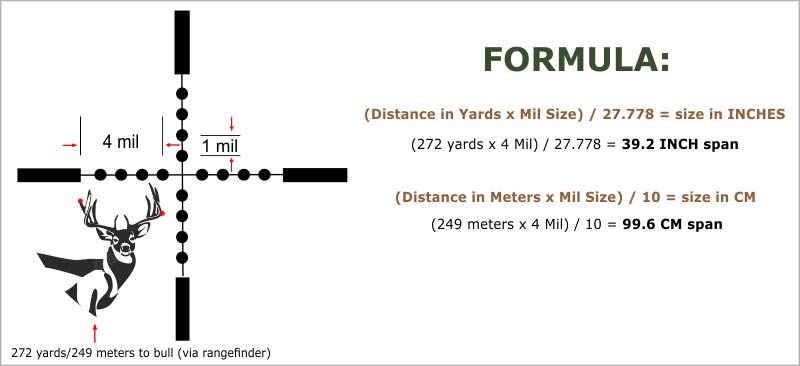
From the image, you can find the formula for determining the size of your target when the distance is known by a rangefinder. You can determine the size in inches or centi meter.
Estimate the Range
To estimate the range, you need to use the Mil-Dot Formula, which is: Target Size (in inches) x 27.778 ÷ Size of the Target in Mil-Dots = Range in Yards. For example, if your target is a prairie dog with a body length of 10 inches and it covers 2.5 mil-dots on the reticle, the range would be 111.1 yards (10 x 27.778 ÷ 2.5).
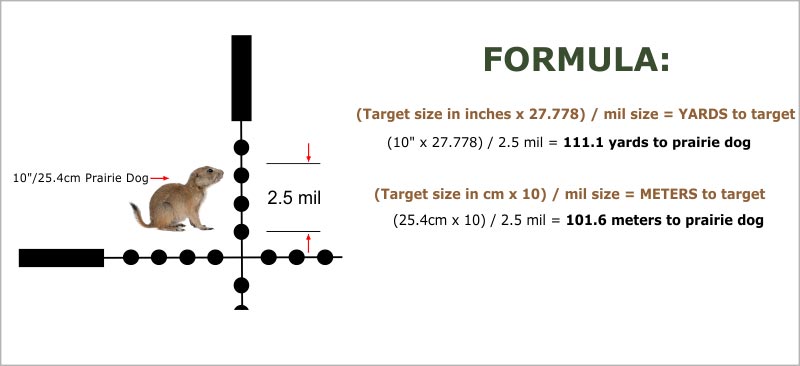
Adjust for Elevation
Once you have estimated the range, you can adjust the elevation turrets on your scope to compensate for bullet drop. To do this, you need to know the ballistic trajectory of your specific ammunition and adjust your turrets accordingly. You can use a ballistics calculator or a range card to help with this step.
Adjust for Windage
If there is wind, you will need to adjust for windage using the Mil-Dot Reticle. You can estimate the amount of wind drift by observing how much the wind is affecting objects in the environment, such as grass or trees. Then, use the windage marks on the reticle to adjust your aim.
Make Holdover Adjustments
Once you have made your adjustments for elevation and windage, you can use the Mil-Dot Reticle to make holdover adjustments. This is necessary because the bullet will still drop over the distance between the shooter and the target. You can estimate how many mil-dots you need to hold over based on the distance to the target and the ballistics of your ammunition.
Practice
Using a Mil-Dot Reticle effectively takes practice. You need to become familiar with the reticle and how to estimate range, adjust for elevation and windage, and make holdover adjustments. Practicing at the range or in simulated shooting situations can help you develop your skills and become more confident in your abilities.
FAQs
What is the functioning principle of a Mil-Dot Reticle?
A Mil-Dot Reticle works by using hash marks or dots spaced evenly on the reticle. These marks help shooters estimate the range of their target, compensate for bullet drop, and make windage corrections.
Can I use a Mil-Dot Reticle Scope for long-range shooting?
Yes, a Mil-Dot Reticle is well-suited for long-range shooting. Its range estimation capabilities and the ability to compensate for bullet drop make it highly effective for shooting targets at extended distances. With practice and familiarity, shooters can aim accurately at targets that are 1000 yards and beyond using the hash marks on the reticle.
How do I zero-in a rifle scope with a Mil-Dot Reticle?
Zeroing-in a scope with a Mil-Dot Reticle involves aligning the point of impact with the center dot on the reticle at a specific distance. To zero with this type of reticle, start by selecting a known distance and firing a group of shots. Then, make adjustments to the turrets on the scope to move the point of impact until it matches the reticle’s center dot. This process ensures that the reticle is calibrated to the rifle’s ballistics and provides accurate holdover and windage adjustments.
Are Mil-Dot Reticle scopes suitable for hunting?
Mil-Dot Reticle scopes can be used for hunting, but they may not be the best choice in all hunting situations. They excel in scenarios where precise holdover adjustments are necessary, such as hunting in open fields or at longer distances. However, for quick target acquisition in dense or close-range hunting environments, simpler reticle types may be more practical for hunters. Consider the specific hunting conditions and your shooting preferences when choosing a reticle for hunting purposes.
How do I estimate range using Mil-Dots?
To estimate the range using Mil-Dots, you need to compare the size of the target to the number of Mil-Dots it covers on the reticle. By knowing the size of your target and the Mil-Dot spacing, you can calculate the approximate distance to the target. For example, if a target measures 18 inches and covers 4 Mil-Dots on the reticle, you can estimate the range to be around 450 yards. Remember that you also need to know the size of the target for accuracy.
What is the significance of bullet drop compensation with a Mil-Dot Reticle?
Bullet drop compensation with a Mil-Dot Reticle allows you to adjust your aim to account for the drop in the bullet’s trajectory at different distances. By using the hash marks on the reticle, you can make the necessary holdover adjustments to ensure your shot hits the target accurately, even when shooting at long distances.
How can I compensate for windage using a Mil-Dot Reticle?
To compensate for windage using a Mil-Dot Reticle, you need to estimate the wind’s effect on your bullet’s path. Observe how much the wind is affecting objects in the environment, such as grass or trees. Then, use the windage marks on the reticle to adjust your aim accordingly. The specific adjustments will depend on the wind speed and direction, as well as the ballistics of your ammunition.
Can I use a Mil-Dot Reticle for shooting moving targets?
While Mil-Dot Reticles are primarily designed for estimating range and compensating for bullet drop, they can also be used for shooting moving targets. By adjusting your aim based on the target’s estimated range and speed, you can increase your chances of hitting a moving target. However, shooting moving targets requires additional skills and practice beyond using just the Mil-Dot Reticle.

Mike Hardesty is a published freelance gun writer. He also possesses specialized expertise in rifle scopes With dozens of articles and reviews published in Pew Pew Tactical, Snipercountry.com, and TTAG (The Truth About Guns), Mike is considered a firearms expert. His special area of expertise is handguns.
Mike is a long-time shooter. He has been punching paper targets, taking deer and other game and shooting at competitions since about 1975. Other related pursuits include reloading and bullet casting. He currently reloads for over 10 calibers, both handgun and rifle. His reloads, particularly for 9mm, were in great demand during the height of the ammo shortage among family and friends. He donated hundreds of rounds to informal shooting sessions. He was quoted as saying “I do not sell my reloads but I sure will help my guys shoot ’em for free!”. He has a few cherished firearms that he has inherited or otherwise procured — those are his favorites.
He earned B.S. and M.S. degrees from Indiana State University in 1974-1975.
He’s a firearm experts and is the founder of mhardesty.com.
